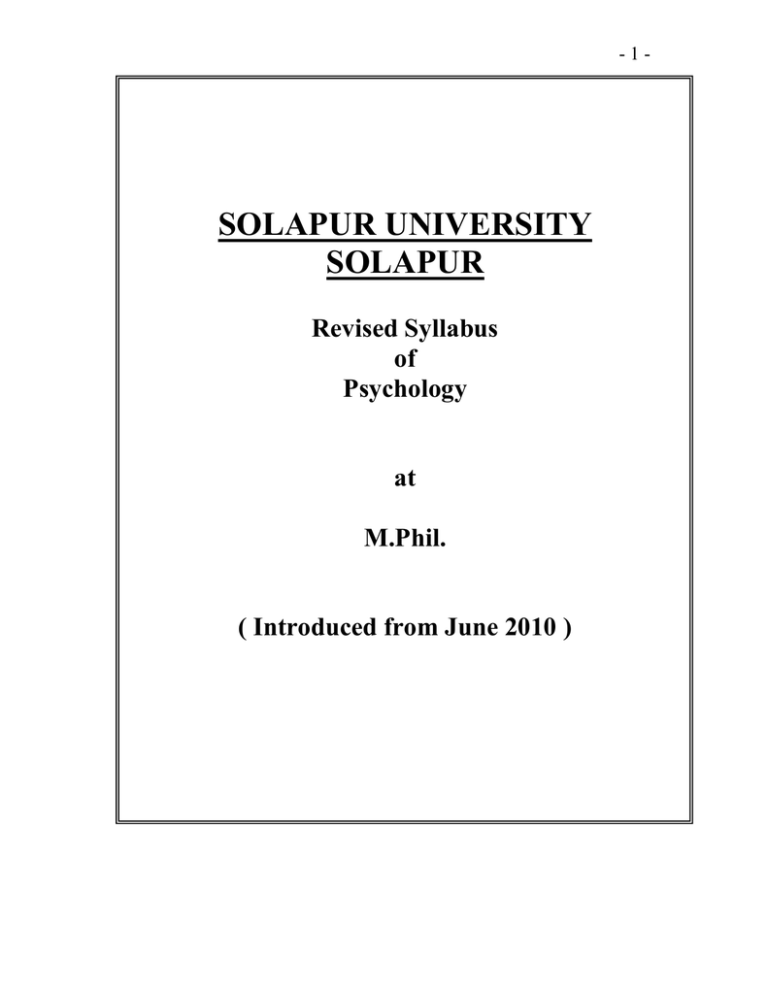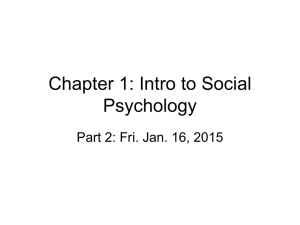
-1-
SOLAPUR UNIVERSITY
SOLAPUR
Revised Syllabus
of
Psychology
at
M.Phil.
( Introduced from June 2010 )
-2-
SOLAPUR UNIVERSITY, SOLAPUR
M.PHIL. PSYCHOLOSY
PAPER – I RESEARCH METHODOLOGY AND COMPUTER
APPLICATION IN PSYCHOLOGY
UNIT-1)
UNIT 2)
UNIT 3)
UNIT 4)
MEANING AND NATURE OF RESEARCH
AND PROBLEM :
1.1 Meaning and objectives of research.
1.2 Types of research and Research approaches
1.3 Meaning & characteristics of research problem and
ethical problems in research.
1.4 Techniques involved in defining a problem.
1.5 Sources of stating problems.
HYPOTHESIS AND VARIABLES :2.1 Meaning and characteristics of good hypothesis
2.2 Types of hypothesis, formulating and ways of stating
hypothesis.
2.3 Meaning and types of variables concepts and constructs.
2.4 Techniques of controlling extraneous variables.
TECHNIQUES OF OBSERVATION, DATA
COLLECTION AND SAMPLING.
3.1 Questionnaire–interview content analysis. observation
as tool of data collection. difference between
participant
observation
and
non-participant
observations.
3.2 Meaning of Rating scales, Types Rating scale, other
types of Rating scale, Problems of obtaining effective
Rating, Errors in Ratings
3.3 Sampling :Meaning types factors influencing decision to sample,
Methods drawing random sampling simple and
stratified sampling , Areas or cluster sampling, Quota,
purposive sampling, Accidental systematic show ball
sampling, saturation sampling, Dense sampling
Doubles of Sampling, Requisites of good sampling
methods.
ANALYSIS AND INTERPRETATIONS :4.1 "t" ratio and analysis of variances
4.2 Factorial analysis of variance
-34.3
4.4
4.5
Meaning of other research design
Different research design
Basic principles of experimental design.
-4UNIT 5)
UNIT 6)
UNIT 7)
UNIT 8)
RESEARCH REPORT AND RESEARCH PROPOSAL
5.1 General purpose of writing a research report.
5.2 Structure of formal of research report
5.3 Style of writing research report.
5.4 Evaluating a research report.
5.5 Preparing a research proposed.
INFORMATION ENCODING :6.1 Number systems and comparison of number System
6.2 Codes
6.3 Multimedia and data compressions
6.4 Data compression - State, Dynamic, Haftman
principle, LZ 77, LZ 78, LZW, coding.
INTRODUCTION OF COMPUTER :7.1 History and Generations of computer
7.2 Characteristics of computers
7.3 Applications of computers
7.4 Classifications of computer
7.5 Organization of computer system
7.6 Software definations, role and categories
7.7 Procedure - CPU and CPU families.
COMPUTER MEMORY AND STORAGE :8.1 Primary Momry
8.2 Random Access Memory ( RAM )
8.3 Inputs and outputs media - CRT Monitors, Flat, Panel
Monitors, Key board, Displaying text in special form
and colour, Graphics and Graphical terminals.
8.4 Printers :- Printing mechanism, Impat Printers non–
impact Printers, plotters.
8.5 Algorithasm and flow charts – Algorithm flow charts,
Basic operations, procedure and programs.
8.6 Programming languages and software methodologyGeneration of language, Linking and loading
8.7 Software Development methodology – Software
engineering
,
Industry
standards,
Software
development life cycle.
-5UNIT 9)
UNIT 10)
COMPUTER NETWORKS AND DATA
COMMUNICATIONS :9.1 Fundamental and Basic concepts in computer network
modem.
9.2 Modes of communication Simplex , Half duplex, full
duplex , FDM, TDM.
9.3 Advanced Communication Techniques ISDN , DSL
9.4 Mobile communication Microwave. Satelite,
Celluar.
9.5 Internet – ARPA Net. TCP / IP, DNS
9.6 Eldronic Mail – World wide web ( www ) search
engines.
APPLICATION OF SPSS PACKAGES
Version 10 onwards :
References :1) Singh A.K. ( 1997 ) Tests Measurements and research methods in
Behaviorial science, Bhati, Bhava, Publication & distributors.
2) Kothari C.R. (2004 Research Methodology methods and
techniques . New Age International Publications.
3) Shaughnessy J.J & Zechemeister E.P. (1997) Research Methods in
Psychology McGraw Hill International Ed.
4) Sinha B.L ( 2001 ) Statistics in Psychology and Education, Anmol
Publications Pvt. ltd. New Delhi.
5) Kahate Atul ( 2007 ) Information Technology. Third Edition
Tata McGraw Hill Publishing company limited, New Delhi.
-6PAPER–II:
ADVANCED TRENDS IN APPLIED
PSYCHOLOGY
UNIT 1) ISSUES IN CLINICAL AND PSYCHOLOGICAL
ASSESSMENTS.
1.1 Planning of psychological and clinical assessment.
1.2 Methods and problems in data collection about clients.
1.3 Processing of assessment information
1.4 Communicating assessment findings to the client.
UNIT 2) TREATMENT OF PSYCHOLOGICAL DISORDERS :2.1 Individual and family therapy - Development counseling
therapy ( DCT ), Systematic Cognitive development therapy
(SCDT) Multicultural counseling and Therapy ( MCDT )
2.2 Psychodynamic counseling and therapy- central constract of
Psychodynamic therapy, free association, interpretation,
dream analysis, RPT, Analysis of resistance. Transference
and countertrasference, Projective identification.
2.3 Cognitive behavioural therapy.
Mechenbaums construction of congnitive behaviour therapy,
Eilis REBT, Glasserrs reality therapy, Beck's, cognitive
therapy. Lazarus multimodel therapy
2.4 Humanistic and existential therapy.
Rogers Person Centred therapy.
Vontress - Searching for life meaning
Frankl's – Logotherapy
Perl's Gestalt therapy
UNIT 3) COUNSELING AND TECHNIQUES OF COUNSELOR.
3.1 Goals of counseling, counseling process, relationship
establishment, problem identification, counseling skills,
communication skills . Short terms counseling.
3.2 Special Counseling Populations :Drug, Tabocco, Alcohole, women, adults, Business and
industry AIDS, victims of Abuse, people with disabities.
People in poverty.
3.3 Group Techniques :- group guidance, group counseling,
group Therapy, T-groups, Sensitivity groups, Encounter
groups, Task group, Minigraps.
3.4 Careers Counseling – Theories of careers development ,
careers counseling and the development of human potentials.
careers planning and decision making in schools. careers
counseling in non school settings, computerized careers
assistance systems.
-7UNIT 4) ASSESSMENT AND EVALUATIONS :4.1 Criteria of selection of tests
4.2 Types of intelligence -Attitude and Achievement tests.
4.3 Tools of personality assessment – Self Report
inventories, interest value, attitudes, NEO- R
4.4 Types of Projective Techniques – Pictorial
Techniques, Rorschach, Hotzman, TAT .
4.5 Halsted, Luria - Neuropsychological Examination.
UNIT 5) ASSESSMENT AND ENHANCEMENT IN INDUSTRY :5.1 Assessment performance
5.2 Definitions and appraisal process
5.3 Appraisal methods – Absolute standard relative
standard MBO approach and 360° appraisal
UNIT 6) MOTIVATION , CONFLICT AND ORGANIZATIONAL
DEVELOPMENT :6.1 Content theories - Maslow, Herzberg, Alderfers ERG,
Theory
6.2 Process theories – Vroom's, Porter- Lawers model,
Equity theory, Attiribution Theory.
6.3 Interaindividual aspects of confilicts :Conflicts and stress from frustration, Goal conflict,
Role conflict
conflicts–The
Johari
window,
6.4 Interpersonal
organizational conflict.
6.5 Organizational Development : Traditional approaches
to organizational development. Other modern
organizational techniques, Transactional analysis in
organizational development.
UNIT 7) HEALTH AND POSITIVE PSYCHOLOGY :7.1 Definition and concepts of health psychology,
psychology involvement in Health.
7.2 Meaning of stress Theories of stress, Measurement of
stress.
7.3 Physiology of immune system. Psychoneuro
immunology, pain and Nervous system. Medical
treatment for stress and pain.
7.4 Meaning and Definitions positive psychology , why
psychology of well – being, what is happiness.
Subjective well being
7.5 Positive Traits : Personality, emotions and biology
positive beliefs.
7.6 Virtue and strength of character Developing a
classification of human virtues, wisdom as
-8fundamental strength and virtue Transcendence –
Religion and spirituality, religion and virtue.
UNIT 8) PSYCHOLOGY FOR BETTER COMMUNITY :8.1 Community psychology
8.2 Characteristics of community psychologists
8.3 Functions of community psychologists
8.4 Indicators of community psychologists
8.5 Problems of community interventions
References :1. Allen E. Ivey, Mary Ivey Lunn Morgan ( 1997 ) " Counseling and
Psychotherapy – Toranto Allyn and Bacien.
2. Gerland Corey – Theory and practice of counseling and
psychotherapy 3rd E.d. ( 1986 ) California Brooks / Cole
publishing company.
3. Weiner B ( 1983 ) clinical Methods in psychology – John Wiley
and sons
4. Neizal Berstein (1995) Introduction to clinical psychology
5. Hecker and Thorpe ( 2005 ) Introduction to clinical psychology –
Jenee Practice & Ethics
6. Walker – Clinical practice of psychology
7. Robert Gibson and Marianne Mitchel ( 2006) . Introduction to
counseling and guidance ( 6th Ed) pearson prentice Hall.
8. Miner J.B. - Industrial and organizational psychology McGraw
Hill.
9. Freud Luthans (2005) organizational behaviour 9th Ed. McGraw
Hill.
10. Robbins K. Stephen – organizational behaviour 9th Ed.
11. Singh A.K. ( 1997 ) Test Measurement and research methods in
behavioural science. Bharati publishers and distribution.
12. Brannon Linda & first Jess (2007) Introduction to health
psychology printed and bond in India by Akash Tiweri, New Delhi.
13. Banmgardner steve R. Crothers Marie K ( 2009) Positive
psychology, Dorling Kindersley India Pvt. Ltd. Pearson Edition.
14. Snyder C.R. & Loper Shane J (2006) Positive psychology, Sagc
Publication Com.
-9PAPER – III- COGNITIVE PROCESS AND
PERSONALITY
UNIT 1) INTRODUCTION TO COGNITIVE PROCESS.
1.1 Brief history
1.2 Psychology in the world.
1.3 Understanding the mind and Brain ( Models )
1.4 Cognitive Brain
1.5 Behavioral Methods, models and modeling
UNIT2) PERCEPTION
2.1 Means of perceive
2.2 Visual perception
2.3 Processing Features of Perception
2.4 Configural Models
2.5 Models of Top-down processing
UNIT3) LEARNING AND REASOING
3.1 Theories of learning in detail
3.2 Emotional Learning
3.3 Rational decision making
3.4 Complex uncertain decision making
3.5 Inductive and deductive reasoning.
UNIT4) MEMORY :
4.1 Comparision and evaluation of STM & LTM
4.2 Theories of Memory
4.3 Episodic Memory
4.4 Misremembering the past, and misatrubution
4.5 Forgetting and compition.
UNIT 5) PERSONALITY PERSPECTIVES
5.1 Dispositional Theories.
5.2 Nomothetic and Idiographic approach.
5.3 Intereactionist approach.
5.4 Type and Trait approach
5.5 Situational approach
UNIT 6) NEED AND MOTIVES APPROACH OF
PERSONALITY
6.1 Need and specific needs
6.2 Theories of motivation
6.3 Motives and motives disposition
6.4 Measuring motives
6.5 Determines of behaviour
- 10 UNIT 7) BIOLOGICAL & PSYCHOANALYTICAL
PERSPECTIVES
7.1 Theories of biological perspectives
7.2 Theories of psychoanalytical perspectives
7.3 Theories of neopsychonalytical perspective
7.4 Ego control. and egoresiliency
7.5 Ego Psychology
UNIT 8) LEARNING APPROACH
8.1 Social learning theories
8.2 Learning theories
8.3 Social cognitive theory
8.4 Phenomenological learning
8.5 Psychosocial Theories
References :
1.
2.
3.
4.
5.
6.
7.
8.
Edward E.Smith & Stephen M. Kossly
Cognitive Psychology mind and Brain ; PHI learning private
limited Eastern economy edn. 2009
Carver C.S. and Scheir M.F. ( 1996 )
Perspectives on Personality 3rd Edition, Allyn & Becon.
Brandynathan (2007 ) Personality Theory and practice, publication
toranto
Allen B.P. ( 1997 ) Personality Theories, Allyn and Becon Pub.
Hall C.S and Lindzey - Theories of personality, recent edition
New York : Wiely estern ltd.
Solso R.L. (2004) Cogintive Psychology, 6th Edition, Bosten :
Allyn & Becon Pub
Sternberg R.J. ( 1996 ) Cognitive Psychology
New York, Harcourt Brace College Pub.
Galotti M. ( 2000) Cognitive Psychology In & out of Laboratory,
Beltmont Books Cole & Wadsworth.
- 11 PAPER IV –DISSERATION
1.
2.
Dissertation text must be more than 100 pages
Dissertation include following steps.
Chapter I - Prologue
1.1 Introduction
1.2 Background of the Problem
1.3 Concepts in the study
1.4 Significance of the study
1.5 Objectives
1.6 Hypothesis
1.7 Limitations
Chapter – II Review of the
Literature
Chapter – III Methodology and Research design
Chapter – IV Results, Interpretation and Discussion
Chapter – V Epilogue
5.1 Summery
5.2 Conclusions
5.3 Recommendations
References
As per APA Style and listed research tools
•
•
•
Medium of instruction and examination Dissertation will be written in
English or Marathi.
The Examinations pattern of M.Phil or Pre Ph.D course as follows .
Three theory papers ( 100 Marks each )
Dissertation (Internal and External referee
out of 100 Marks each )
Viva – voce ( Internal and External referee
out of 50 marks each )
300 Marks
200 Marks
100 Marks
Total 600 Marks.


